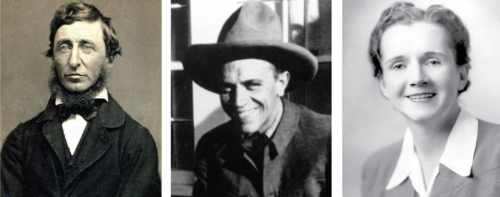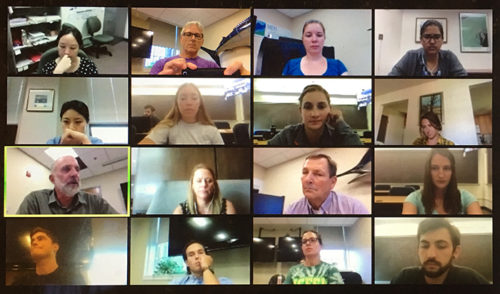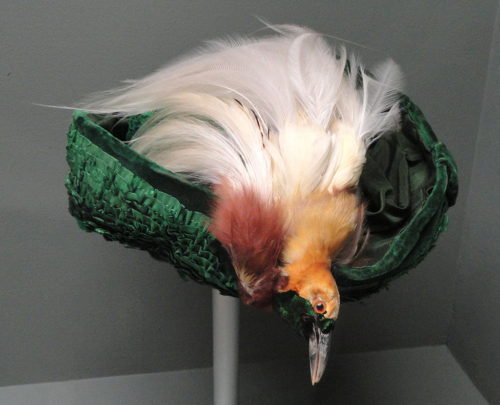From Walden to Now: A Look at the Environmental Movement in the USA
Alex Sahi ·By: Alex Sahi
This week marked the beginning of discussion-based classes for the students in MEES620 Environment and Society. We all took a few extra minutes to settle into our seats and understand the Zoom internet calling system, a new innovative web seminar forum that allows students from College Park, Horn Point, Appalachian Lab, and beyond to interact with each other. Once all the kinks were worked out, the students reintroduced ourselves so that we could quickly start our conversation about the beginnings of the environmental movement in the United States.
Our professor, Bill Dennison, provided a summary and review of the three formative works that we were asked to read for this week's class: Walden by Henry David Thoreau, The Land Ethic by Aldo Leopold, and Silent Spring by Rachel Carson. These three works sparked many discussions in our online classroom, as they have also done for many environmentalists over the past 150 years since Walden's release. While each work has a distinct focus, they were all written for mass appeal, broadly marketed, and available for the general public.

Walden describes a period of two years, two months, and two days, during which Thoreau lived simply and found himself through nature. He strived to coexist with nature and break away from the luxuries in the United States at the time. As Dr. Dennison highlighted during the class, Thoreau says "If a man does not keep pace with his companions, perhaps it is because he hears a different drummer. Let him step to the music which he hears, however measured or far away"1. It is this drumbeat that highlighted that nature was in peril and led to the creation of environmentalism2.
Almost one hundred years later, many of the recurring ideas in Walden inspired The Land Ethic to be written. Author Aldo Leopold saw the idea of an ethic towards the environment as the next logical progression of American philosophy. To illustrate this point, Leopold used a parable about Odysseus returning from his journey away from home after the Trojan War. After returning home, Odysseus killed his slaves, which was seen as an acceptable practice at the time but is considered unacceptable today3. Leopold argued that this example shows that ethics must keep moving forward, and the next step was to have an ethic that revered the land, water, and biota.

Our class discussion continued on the theme of the power of parables, and we discussed Rachel Carson's use of imagery of a town that withers and succumbs to sickness. As Carson described various plights she remarked, "Yet every one of them has actually happened somewhere in the world, and many communities have already suffered a substantial number of them"4. Her story, similar to Leopold's, draws the reader in and immediately captures their imagination and attention. Some of my fellow students really appreciated this style of writing, especially the gut punches that Carson threw in at the end of each section. Is it this humanizing factor of environmental works that makes pieces like Silent Spring and The Land Ethic so enduring? Maybe we can all try to use these literary techniques more in our work to help give more context to our own research.
After discussing the context and background of the works we read, we moved on to a discussion based on questions we formulated during our reading and essay writing. This proved to be a fruitful conversation once we started to get a feel for how the Zoom system operated! We all worked out some logistical issues in the middle of class, and the College Park group even relocated to the conference room for better audio conditions. To facilitate our class discussion, Dr. Dennison shared some of the insightful questions written by my colleagues. Although we touched on many topics throughout our class, a few stood out and are highlighted here.

The first topic was a conversation on the interplay of religion and environment. The question that provoked us asked how important religion is in the environmental movement, going forward? And after a few moments of silence, Dr. Michael Paolisso sparked the conversation by simply stating, "Very important," with a slight smile. As we conversed back and forth, a fellow classmate brought up the Bible, and the idea that animals were created first for domination by people. Dr. Paolisso and Natalie also shared examples of their work in the Chesapeake Bay and Louisiana respectively, that had to do with working with faith leaders to encourage sustainable use of resources and promote environmental action. I believe that we could have spent all class talking about the role of religion and spirituality in the environmental movement because the topic provoked a unique response from everyone in the room. I began thinking during this part if a week of this "Environment and Society" class ought to be be devoted to the topic of religion in the future.
One more discussion topic I will highlight is the importance of birds in the environmental movement and conservation efforts. This topic was initiated by Emily's question asking about the significance of birds' involvement in all three readings. Birds play an integral role in the conservation movement, as they were one of the first animals that people intended to save in the modern United States. This was due to the fact that the feathers of most birds were used for hat making, which was a very profitable business. It was also brought up that birds are sometimes the most easily accessible form of nature for people worldwide. Birds also are the first to feel environmental stressors and triggers, and can serve as the "canary in the coal mine," if you will.

As I wrap up the first blog segment for this class, I am left with many questions, but also with a feeling that many more good points and thought-provoking questions will arise in future weeks. The three authors discussed this week provided us three unique ways of looking at the environment and environmental problems. The diversity in background of the students in this class helped shine a light on multiple facets of these readings, and I look forward to hearing everyone's perspectives in the weeks to come!
References
1. Thoreau, H. D. (1854). Walden. Boston: Ticknor and Fields.
2. Charles, Adam, and Pat. (n.d.). The Environmental Movement: A timeline of key events. Retrieved September 6, 2018, from https://sites.google.com/site/thewesterngreen/publications.
3. Leopold, A. (1948). The land ethic. A Sand County Almanac. na.
4. Carson, R. (1962). Silent Spring. Houghton Mifflin.
Next Post > Lessons learned from the Sunbelt Social Network Conference
Comments
-
Brendan Campbell 7 years ago
Well put Alex! In the modern day it is hard to believe that someone would voluntarily decide to live in a place so small and simplistic as the cabin at Walden Pond. But then again, I suppose that was his argument in the end.
Anyhow, I appreciate you bringing up the discussion of parables that we had. I thought this was a particularly important discussion for me since initially, I was not fond of a fictional case study in scientific literature, but after hearing everyone's take on the impact that Carson's story had in setting up the remainder of the reading convinced me to be more open to such literary devices and not stick to the pure science as I tend to prefer.
Srishti, I have to agree with you in that this first set of readings puts the class into perspective and behind the foundation. As we read these cases on environmentalists of different time periods you can see how the approaches adapt and evolve to reach the public audience of their respective time to build upon the understanding and appreciation for science.
-
Brian Scott 7 years ago
It has been years since I first read Walden. I could read it in 10 years and, like now, I will come away with something different. I had not read Leopold or Carson before. I just knew about them. Such a difference reading their works. All three authors have widely different perspectives, experiences and issues. Yet, somehow, they are somehow saying the same thing. Our technological advancements have consequences, many of which are not apparent in our daily lives. The works of Leopold, Thoreau and Carson help make the transparent tangible.
-
Shannon Hood 7 years ago
What a great synopsis! One of my favorite moments in this class period was hearing a classmate describe why she has become an avid birder. Her face lit up and she spoke with an excited and genuine affinity for our avian friends. It made me see that we all experience and appreciate nature for different reasons, and we can learn a lot about each other and the natural environment through understanding how other people appreciate the natural world.
-
Srishti Vishwakarama 7 years ago
Great job in the Blog!
I was amazed to see how Thoreau, Leopold, and Carson have so modern thinking at that time. They were way ahead in imagining our future. Though they were hitting different targets, I found their articles really engaging. The follow up discussion in the class was interesting as well. Vast ideas comes into a plate when everyone were putting forward their points for any question.
The first class was a good beginning to introduce us to the basic idea behind the foundation course.
-
Michael J. Paolisso 7 years ago
Well done Alex. Nice to see this environmental side of you. Nicely written and informative.
-
Alana 7 years ago
Alex,
Great summary of the Class! Im glad you weaved together the Zoom issues with our topics of discussion. The works by Leopold, Carson, and Thoreau are foundational works that illustrate different approaches to environmental thought, which we will no doubt keep revisiting. The end of your blog reflects all of our sentiments towards this class and looking forward to future discussions.
-
Tan Zou 7 years ago
Thank you, Alex, for this nice summary! You helped me walk through the thoughtful readings and the stimulating discussion again. Your blog can also help people who have not attended the class understand the key points in the readings and the most exciting topics we covered during the discussion. I think this is one of the reasons why we have this blog!
I have two questions here:
1. Should the person who writes the blog behave like a blogger or a reporter? A reporter simply describes what happened, but a blogger can add more personal perspectives. They can also list the questions they have before the discussions and tell us whether they get answered after the class.
2. Can we add links and books people mentioned in the class to the blog? Alex has mentioned interesting discussion topics beyond the readings. Readers insider and outside the class may also find them interesting and want to know what other readings we would recommend for them to deepen their understanding.
-
Jessie Todd 7 years ago
I really enjoyed the pictures you chose to convey our class period. I think it gives the reader (insider or outsider) something visually to connect with. I liked your Thoreau summary and the class discussions because it has been a few years since I read Thoreau when I was a freshman in college, similar to what Brian said. It was great to hear even more perspectives and ideas drawn from Thoreau than what I would have thought of myself. Great first blog.
-
Emily Nastase 7 years ago
Great summary and well written! I think you really captured the highlights of each reading.
Morgan, you make a really great point that these three articles, each from 70+ years ago, still have surprisingly relevant points. Our perspective toward the environment hasn't changed much since the 1800's. We've seen countless advancements in technology and social justice, and yet we seem to still be behind the times with regards to our attitude toward the environment. Unfortunately, I think we still have a long way to go from here.
-
Morgan Ross 7 years ago
Alex, thank you for stepping up and being the first class member to post a blog. You did a great job.
During the readings and in the class discussion, I was baffled by how the points made by Thoreau, Leopold, and Carson still seem so applicable today. In some cases, we have made improvements towards our perspective of the environment, but at the same time, none of the issues brought up in these readings have truly been resolved. Often times when I receive a class assignment from an older article, the information seems outdated. I cannot say this rings true in the case of these readings.
All three of these works should be required reading students in any discipline.
Having a discussion about the foundation of the environmental movement was the perfect way to start off this class.

